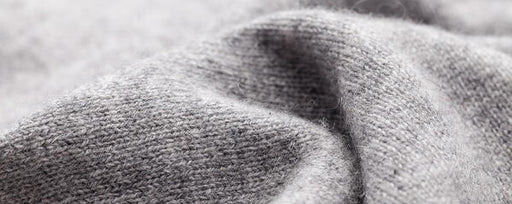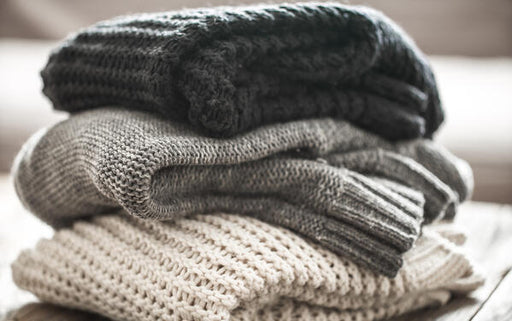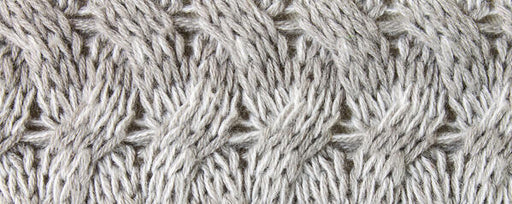How To Remove Stains From Cashmere

Stains can cause disastrous damage to textiles like cashmere. Not only can certain substances degrade the strength and connective bond between the wool fibers, but remnants of any stain can attract clothes moths and larvae that thrive on these leftovers.
Clothing moth traps in your closet may help intercept those flying moths that make it into your bedroom, but you're playing roulette with your cashmere if you're storing it with a stain.
Spot treatment and stain removal for natural fibers like cashmere wool differ from synthetic materials. The usual household remedies won’t always work, and since you need to act fast when it comes to getting rid of stains on your favorite cashmere garments, knowing what your options are before the worst happens is important.
Common Types of Cashmere Clothing Stains
When you’re evaluating stain removal options, your choices will center around the type of stain you’re attempting to remove from your cashmere clothing. Some solutions can be used for a variety of substances while others are only good for certain types of stains.
- Tannin. A lot of drinks cause stains due to their tannins, such as wine, tea, coffee, beer and natural fruit juices (including tomato juice). Soda drinks and chocolate can fall under this category, as well as many types of watercolor or washable markers and inks. Many fruits, like berries or root vegetables, also have tannins that can stain clothing.
- Dye. While synthetic dyes, like those used in some inks and food products, certainly fall under this category, spots and streaks from grass would also be treated as a dye-based stain. These types of stains can also occur when an article of clothing is washed with cashmere and bleeds its dye into the garment.
- Oil. Some oil-based stains come from natural sources, like animal or plant by-products such as bacon fat or certain cooking oils. Cosmetic products, such as make-up, creams and body lotions, also produce oily stains. Automotive fluids and paint products may also leave oil-based stains that can prove particularly difficult to remove.
- Protein. Many natural and animal-based by-products are considered protein stains. This can include foods that do not fall under tannin or oil-based categories, such as eggs or dairy products. Body fluids, such as urine, blood or vomit are also in this category. Animal droppings would also be classified as a protein-based stain.
- Combination. Due to the various ingredients in many prepared foods or manufactured products, a stain can be any combination of the above types. This complicates the stain removal process, and you may need to use more than one removal technique. Examples of products that might leave a combination stain include ketchup, mayonnaise, candle wax, or shoe polish.

Removing Stains from Cashmere Clothes
While there may be a variety of remedies for different types of stains, only a select few will be safe for cashmere garments. Because cashmere is made of short strands of natural wool fibers, it’s highly susceptible to damage when exposed to harsh chemicals or rough treatment. Caring for cashmere requires delicate handling. Scrubbing or bleaching a stain out simply isn’t an option with cashmere.
Cold water on Cashmere
If you have no other options available to you when a spill or spot occurs, do these two things: stay calm and use cold water. It’s natural to think that hot, soapy water will beat any speck of dirt or debris into submission, but heat is the enemy of cashmere and can even render certain types of stains, like tannin-based ones, permanent fixtures. If you can’t remove the cashmere garment to rinse the stain beneath a stream of cold water, then dampen a napkin or cloth and blot the area carefully. Be careful to keep your blotting gentle and avoid stretching the area since wet cashmere can lose its shape easily.
Scoop solids off stained Cashmere
When the accident involves a blob-like splotch of the offending substance, like peanut butter or ketchup, you can minimize the spread of wet and oily by-products by scraping off the majority of the substance with the back of a knife or the side of a spoon or fork. Even the edge of a credit card or stiff paper would work. Whatever you use, wield it with care and avoid pressing too hard against the fabric as you scoop up the spill. Carry on with a cool water rinse or blot from there.
Safe soaps for Cashmere clothing
Wool-safe soaps are best, but if you’re dealing with a stain outside of your own laundry room, then you need to know which alternatives are best. Most unscented dish soaps are pH-neutral, therefore they’re a safe bet when you need a home-made stain remover in a pinch. Regular laundry detergent that’s labelled as gentle for sensitive skin is also a good candidate for pre-treating a stain. Mild baby shampoo or soap is also life hack-approved for stain removal when you need to act quickly. It’s best to dilute any of these soaps a little and dab onto the spot until it’s fully saturated. Allowing this to soak for a few minutes before rinsing it with clean, cold water increases its effectiveness.

Vinegar rinses for Cashmere sweaters
While vinegar won’t help with stains from foreign substances, a cold water rinse with a quarter to three-quarters cup of white distilled vinegar can stifle body odors and the yellowing that happens from perspiration transferring from the body to the garment. This is especially effective in the underarm areas of sweaters where sweat is likely to settle in. You may not notice any staining until you’ve washed the garment or brought it out of storage, so it’s good to get in the habit of incorporating this step any time you hand or machine-wash when caring for your cashmere clothing.
Specialty products for Cashmere
As with detergents, stain removers that are specifically formulated for safe use with cashmere are must-have items for any wool enthusiasts laundry room. The best ones use plant-based, non-toxic ingredients without any petroleum products or artificial colors. If you don’t have a cashmere-safe stain remover on hand, a concentrated amount of your usual wool-friendly detergent can be used to spot-treat prior to washing.
Professional services for cleaning Cashmere
While the harsh solvents found at a dry cleaner’s aren’t always safe for use with cashmere textiles, you may still need the help of a professional if you have a particularly stubborn stain that won’t respond to normal stain removal techniques. You can consult with your dry cleaner about which products they have that pose the least risk of damaging or dulling your favorite cashmere garment.
Find out more information about dry cleaning your clothes in our article aboutwhat clothes can be dry cleaned.

Washing Cashmere After Stain Removal
If you’ve spot treated your stain and it looks like it’s still there, don’t panic. This is common with many types of stains, especially those from protein or oil-based substances. Many times, a full wash is all that’s necessary when this happens, even if you have to wait awhile before you’re in a place to give your cashmere the attention it needs post-stain.
Even if your stain removal technique is fully successful, you should always hand or machine-wash your cashmere garment as soon as possible after that spot treatment. When you’ve dealt with especially stubborn stains, you will probably find hand-washing is more effective and more controlled than tossing it into the washing machine for a spin. Remember that cashmere responds best to cool water, mild detergent and gentle squeezing to release excess water. Once washed, reshape the garment as it should be and allow it to dry flat.
Knowing your options for stain removal with cashmere clothing allows you to wear your favorite pieces with confidence and keep them looking good as new for as long as you own them.
Read more on our blog about washing cashmere.
FAQ's for How to Remove Stains from Cashmere
Now that you know how to keep stains from ruining your favorite cashmere sweaters, tops, and scarves, let’s answer a few frequently asked questions about cashmere care. That way, you can keep your cutest cashmere outfits stain-free and moth-free.
How to remove old stains from cashmere?
Forgetting to remove a stain right away (preferably, while it is still wet) can make it a lot harder to eliminate later. However, sometimes you don’t realize a garment has become stained until much later. Life happens! The good news is that old and dried stains can usually be removed from cashmere.
To remove dried stains from cashmere, mix 1 and 1/2 teaspoons of baking soda with about 1 cup of lukewarm water. Then, find a lint-free cloth that won’t transfer colors. Preferably, a white cotton cloth or linen rag.
Dip the cloth into the baking soda solution. Then, use it to lightly dab around the stained area. Press gently, and do not rub too vigorously. Continue the process until the stain starts to lift. Rinse the cloth, dip it again, and repeat the dabbing process as needed, until the stain is completely gone.
How to remove sweat stains from cashmere?
Cashmere can be extremely warm and cozy. It can also make you sweat, leading to unappealing sweat stains. Sweat stains are easiest to remove while still damp. If your cashmere sweater or top has gotten sweaty, rinse it in cold water as soon as possible. After rinsing it, gently clean it by hand with a few drops of cashmere-friendly detergent.
After this pre-treatment, let your garment soak in cold water until the stains are completely lifted. A final cold water wash with a little bit of gentle, cashmere-safe detergent should get rid of any lingering odors or stains. Vinegar rinses can also be an effective way to treat the underarm areas of cashmere sweaters. Vinegar rinses are a great way to remove any lingering odors and can be a great step to add to your cashmere care routine.
How to safely remove stains from cashmere?
The easiest way to remove stains from a cashmere garment is to treat them right away while they're still damp. As soon as you notice a stain, quickly rinse the affected cashmere material using cold water. You can also add a few drops of cashmere wash or any other gentle, wool-friendly detergent and clean the area by hand under a cool tap.
If the stain doesn't lift right away, let the garment soak in cool water for about 15 minutes. Then, you can hand-wash the stained area again with safe detergent. Finally, wash your cashmere garment on the gentle or wool cycle, as always, in cold water.
Will baking soda ruin cashmere?
Generally, baking soda is considered safe for use on the short, wooly fibers of cashmere. It can lift stains and reduce odors on natural fabrics safely. Baking soda can be particularly effective on greasy stains. However, it may damage the dyes of certain cashmere garments. So, be careful using baking soda on dark or vibrant cashmere clothes, and always use your best judgment.
Can you use vinegar on cashmere?
Yes, vinegar rinses can stifle body odors and help to prevent the yellowing caused by perspiration transfer on a cashmere garment. Vinegar is especially effective in the underarm areas of a cashmere top. Incorporating a vinegar rinse into your hand-washing routine is a great way to care for your cashmere overall.
How do you fix ruined cashmere?
Cashmere is a delicate natural material that can be subject to staining, shrinking, and moth damage. Clothes Moths will lay their eggs on animal based fibers such as cashmere. Stained cashmere is a feast for their Moth Larvae. Sometimes, cashmere garments are ruined beyond repair. However, small holes in cashmere caused by Clothes Moth Larvae can occasionally be mended using a similarly colored cashmere thread. Additionally, shrinkage from washing cashmere in hot water can also occasionally be reversed by hand-stretching.
To unshrink a cashmere sweater by hand, gently run it under cold or lukewarm water. Symmetrically pull the fibers apart with your fingers in an even pattern as the garment dries on a flat, even surface. You may have to re-wet your garment and repeat this gentle pulling process a few times to fully “unshrink” cashmere. Be sure never to wash that same garment in hot water again, as you may not be able to fix it a second time.
Does cashmere get ruined by water?
Contrary to what many people think, cashmere will not be ruined by water. In fact, the fibers are water-repellent, and regularly washing your cashmere clothes can even make them softer. However, you must never wash cashmere fibers in hot or even very warm water. This can cause serious damage and shrinkage. Instead, always use tepid or cold water to wash all cashmere garments.
About MothPrevention
MothPrevention® speak to customers every day about their clothes moth issues - clothes moths are a species that are ever increasing and that can cause significant damage to clothes, carpets and other home textiles.
To date, we’ve helped over 250,000 customers deal with their moth problems. We have developed professional grade solutions including proprietary pheromones and trap design, not available from anybody else in the USA.





